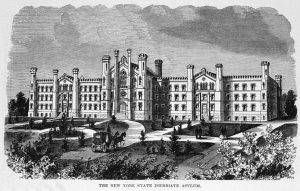 The topic of addiction recovery is illuminated by the stories of individuals and families, but there is a larger story that can be recounted in the classic three-part story style of recovery: "what we used to be like, what happened, and what we are like now." That larger story sets the context for those more personal stories via the evolution of cultural responses to severe alcohol and other drug problems. Today's blog recalls one dark and prolonged chapter within this larger story.
The topic of addiction recovery is illuminated by the stories of individuals and families, but there is a larger story that can be recounted in the classic three-part story style of recovery: "what we used to be like, what happened, and what we are like now." That larger story sets the context for those more personal stories via the evolution of cultural responses to severe alcohol and other drug problems. Today's blog recalls one dark and prolonged chapter within this larger story.
If there is a dividing line in the modern history of U.S. responses to alcohol and other drug addictions, that line could well be drawn in 1970--the year landmark legislation was passed that laid the foundation for a national network of addiction treatment resources. Like the personal turning points found in so many recovery stories, what became popularly known as the "Hughes Act" cleaved the history of addiction treatment in America into the categories of before and after. I am part of a fading generation of addiction professionals whose lives extend into the before era. No discussion of specialized addiction and other recovery support resources is complete without reference to the time when such resources did not exist in most communities.
When 19th century addiction treatment institutions and recovery mutual aid groups collapsed in the early years of the 20th century, people with severe alcohol and other drug addictions were sequestered in four alternative institutions: the private "drying out" sanitarium, the inebriate penal colony, the "foul cells" of the public hospital, and the "back wards" of aging state psychiatric asylums. The role of the latter in the treatment--public control--of addiction extended from the late 19th century through the first half of the 20th century, and was memorialized in Ken Kesey's One Flew over the Cuckoo's Nest.
I entered the addictions field in the 1960s in Illinois during the heydays of the movement to deinstitutionalize the treatment of mental illness in America. Two of my earliest tasks were to help transition persons with histories of addiction from the states' psychiatric hospitals into the community and to help build systems of community care that could prevent such hospitalization and the frequent re-hospitalizations that often followed. Part of that responsibility involved screening patients for potential community reentry from more than 20 of the state's psychiatric hospitals. Most of these facilities were first opened between 1847 and 1925 and were scattered across Illinois in cities with institutions bearing their names, e.g., Alton, Anna, Chester, Chicago, Elgin, Galesburg, Jacksonville, Kankakee, Manteno, Peoria, and Tinley Park. Here are my recollections of my visits to these facilities in the last days of the asylum era.
Institutions founded by reformers as places of sanctuary and healing had devolved into institution of isolation, control, and maltreatment. Building complexes grown so large they existed as small cities filled with thousands upon thousands of longtime residents disconnected from family and community. Once majestic buildings fallen into disrepair. Big jangling key rings hanging from the sides of muscled orderlies who controlled entrance to and egress from locked wards. Shadowed hallways so long they felt like highways. People in large numbers in the "day area" sitting silently, endlessly rocking, or pacing. "Alcoholic wards" filled with the wreaking pungency of paraldehyde, sweat, urine, and disinfectant. "Hydrotherapy" tubs and sweat-stained straightjackets. Graffiti-decorated detox and seclusion cells. A distinct patois used by staff that mimicked the voice adults use to speak to small children or old people. A pervasive sense of despair and resignation that permeated the postures and communications of both patients and staff. A special contempt for "hard core" alcoholic patients ("chronics"/"retreads"), whose perceived malingering demanded attention that was thought far more deserving by those who were "truly sick." Heartbreaking stories not just of addiction and its devastating consequences, but of ill-chosen and ill-executed treatments gone horribly wrong: stories of hundreds of "shock treatments," stories of "discharge contingent upon surgical sterilization," stories of massive doses of psychotropic medications evident in stoned appearances and staggering gaits, stories of prefrontal lobotomies, stories of years of institutionalization after being branded "incurable," and stories of physical and sexual abuse experienced at the hands of staff and other patients. Addicted patients also exploited via "work therapy" because of their skills and high level of functioning once detoxified. Patients pleading desperately for help in getting out.
That some people actually began their recoveries in such an environment is testimony to their resilience and the care of those staff who sought to make human what had morphed into a most inhuman environment. The day of the asylum ended in the wake of new ideas and new treatment methods that would later also come under attack, but the passing of that earlier era marks the birth of modern addiction treatment. No matter what flaws exist in the present system of care for addiction, and those flaws are numerous, we must not forget what it was like in a world in which that system of care did not exist. To those who closed the asylum chapter and opened a new era of community-based treatment, we--as a country, as a profession, and as a community of recovering people--owe you a great deal.